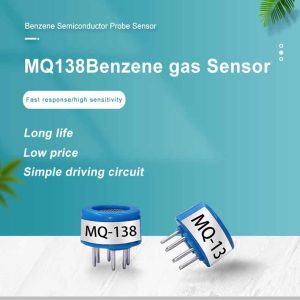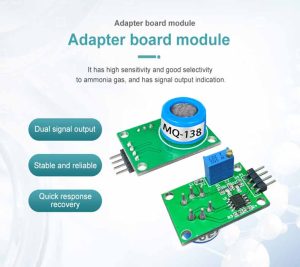Air pollution is a global environmental issue that poses significant risks to human health and the environment. The degradation of air quality is primarily caused by emissions from industrial processes, vehicle exhaust, and the burning of fossil fuels. Monitoring air quality is crucial for understanding the extent of pollution and implementing measures to mitigate its impact. Gas sensors have emerged as a powerful tool for real-time air quality monitoring, enabling us to make informed decisions regarding public health and environmental protection.

Gas Sensors:
An Overview Gas sensors are devices that detect and measure the concentration of specific gases in the atmosphere. They operate based on various principles, including electrochemical, semiconductor, optical, and catalytic reactions. Gas sensors can detect a wide range of pollutants, including carbon monoxide (CO), nitrogen dioxide (NO2), ozone (O3), sulfur dioxide (SO2), volatile organic compounds (VOCs), and particulate matter (PM). These sensors are compact, portable, and can be deployed in diverse environments, making them suitable for both indoor and outdoor air quality monitoring.
Advancements in Gas Sensor Technology Over the years, advancements in gas sensor technology have significantly improved their performance and reliability. Some key advancements include:
-
Miniaturization:
- Gas sensors have become smaller and more compact, enabling their integration into wearable devices, smartphones, and Internet of Things (IoT) platforms. This miniaturization has expanded their applications and made air quality monitoring more accessible.
-
Selectivity:
- Gas sensors now exhibit enhanced selectivity, allowing them to distinguish between different gases with higher accuracy. This selectivity is achieved through the use of specific materials and advanced sensor designs, reducing false readings and improving measurement precision.
-
Sensitivity:
- Gas sensors have become more sensitive, capable of detecting even trace amounts of pollutants. This increased sensitivity enables the detection of low-level concentrations that may still pose health risks.
- Response Time: Gas sensors now offer faster response times, providing real-time monitoring capabilities. This allows for immediate action to be taken in response to sudden changes in air quality, such as during pollution events or industrial accidents.
Applications of Gas Sensors in Air Quality Monitoring Gas sensors have a wide range of applications in monitoring air quality and assessing exposure risks. Some notable applications include:
-
Urban Air Quality Monitoring:
- Gas sensors can be deployed in urban areas to monitor air pollution levels in real-time. This data helps identify pollution hotspots, evaluate the effectiveness of emission reduction strategies, and inform urban planning decisions.
-
Indoor Air Quality Monitoring:
- Gas sensors are used to assess indoor air quality in homes, offices, and public buildings. They detect pollutants originating from cooking, cleaning products, building materials, and inadequate ventilation. By monitoring indoor air quality, measures can be implemented to improve occupant health and comfort.
-
Industrial Emission Monitoring:
- Gas sensors are employed in industrial facilities to monitor emissions and ensure compliance with environmental regulations. By continuously monitoring pollution levels, industries can identify process inefficiencies, optimize operations, and reduce their environmental impact.
-
Personal Exposure Monitoring:
- Gas sensors integrated into wearable devices enable individuals to monitor their personal exposure to pollutants. This empowers individuals to make informed decisions regarding outdoor activities, such as exercise or commuting routes, to minimize exposure to harmful air pollutants.
Benefits of Gas Sensor-Based Air Quality Monitoring The use of gas sensors in air quality monitoring offers several benefits:
-
Public Health Protection:
- Real-time monitoring of air quality provides timely information on pollutant levels, enabling authorities to issue health advisories and take appropriate measures to protect public health. This includes implementing pollution control strategies, issuing alerts during severe pollution events, and promoting behavior changes to reduce exposure.
-
Environmental Conservation:
- Gas sensor-based monitoring helps identify pollution sources and assess the impact of human activities on the environment. This information can guide policymakers in implementing effective pollution control measures, reducing emissions, and preserving ecosystems.
- Data-Driven Decision Making: Gas sensor data provides valuable insights for decision making in various sectors. This includes urban planning, transportation management, industrial process optimization, and policy formulation. Real-time monitoring enables proactive measures to be taken, minimizing the adverse effects of air pollution.
Challenges and Future Directions While gas sensors have revolutionized air quality monitoring, several challenges remain:
- Calibration and Maintenance: Gas sensors require periodic calibration and maintenance to ensure accurate and reliable measurements. Regular calibration is necessary to account for sensor drift and maintain measurement precision.
- Sensor Interference: Gas sensors may experience cross-sensitivity or interference from other gases or environmental factors. This requires careful calibration and data interpretation to obtain accurate pollutant concentrations.
- Standardization: There is a need for standardized protocols and methodologies for gas sensor calibration, data collection, and validation. Standardization will enable data comparability between different monitoring stations and enhance the reliability of air quality assessments.
- Data Analysis and Interpretation: The large amount of data generated by gas sensors poses challenges in terms of data analysis and interpretation. Advanced data analytics techniques, including machine learning algorithms, can help extract meaningful insights from complex air quality datasets.

Conclusion Gas sensors have emerged as a powerful tool for real-time air quality monitoring. Their advancements in technology have enabled accurate and timely detection of air pollutants, helping protect public health and the environment. Gas sensor-based air quality monitoring has diverse applications, ranging from urban areas to indoor spaces and industrial facilities. Leveraging the potential of gas sensors in air quality monitoring requires addressing challenges such as calibration, standardization, and data analysis. By doing so, we can harness the full potential of gas sensors and create a healthier and cleaner environment for future generations.
 : +86 155 8830 2704
: +86 155 8830 2704 : jxdziot@gmail.com
: jxdziot@gmail.com
